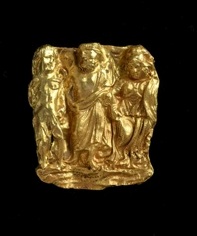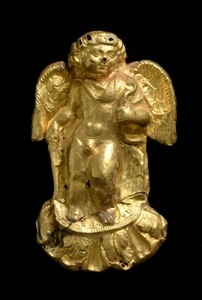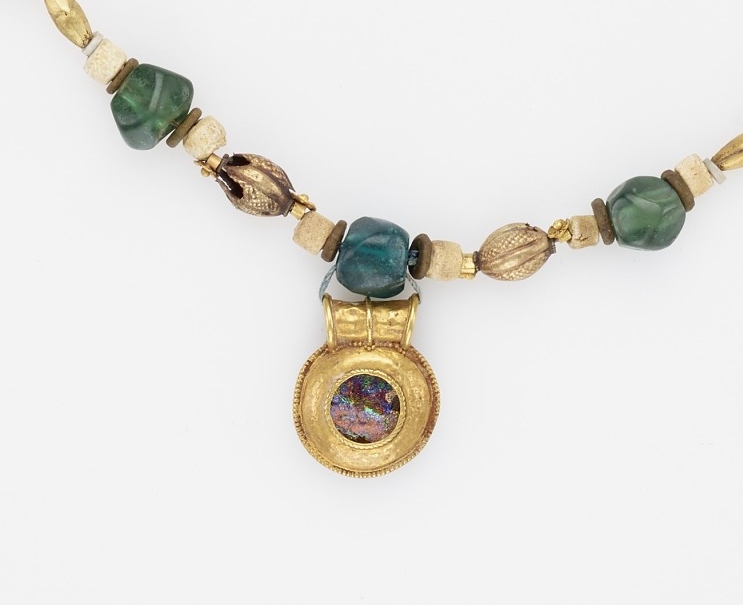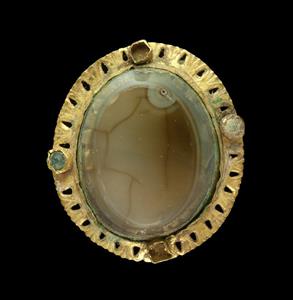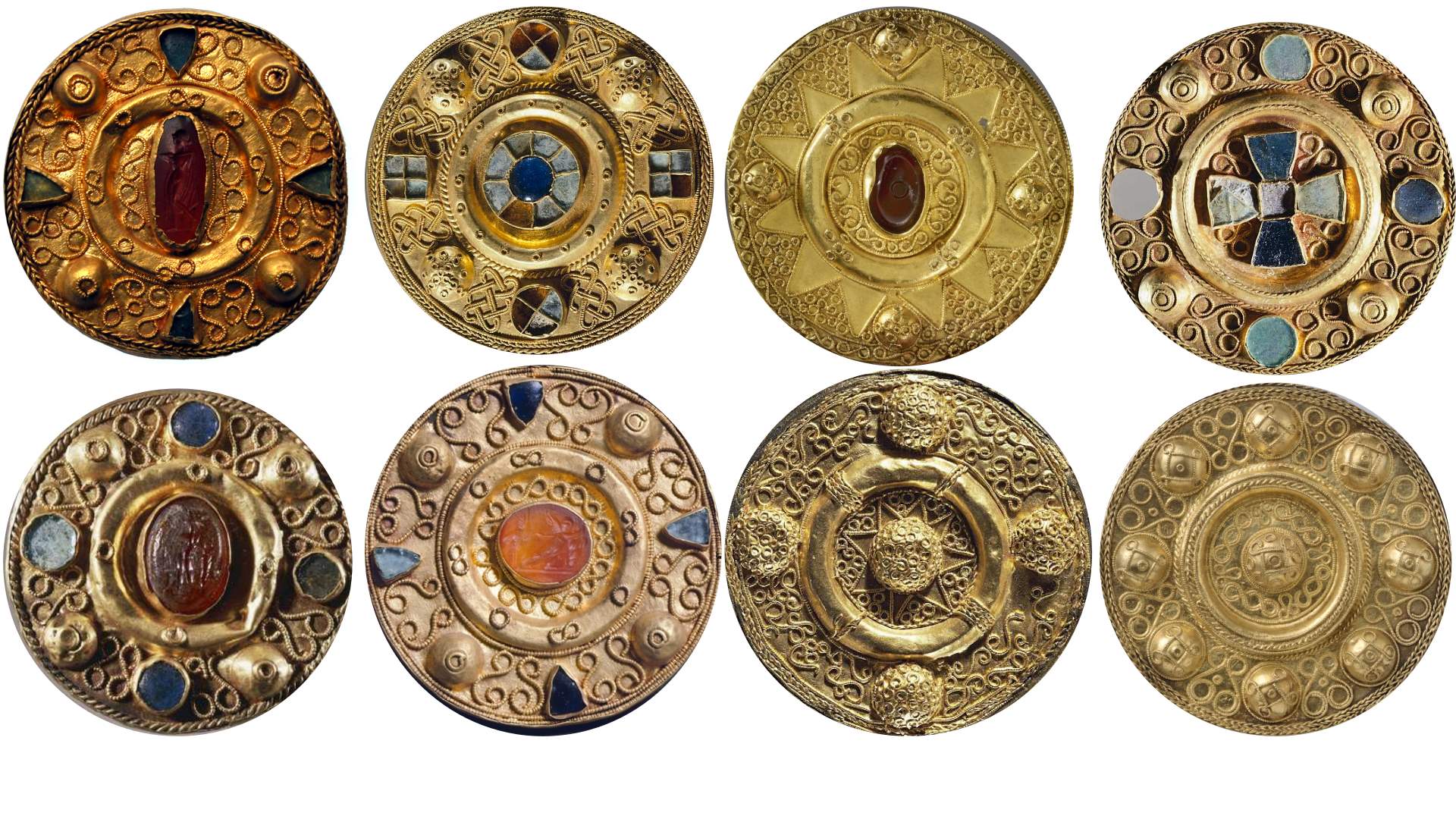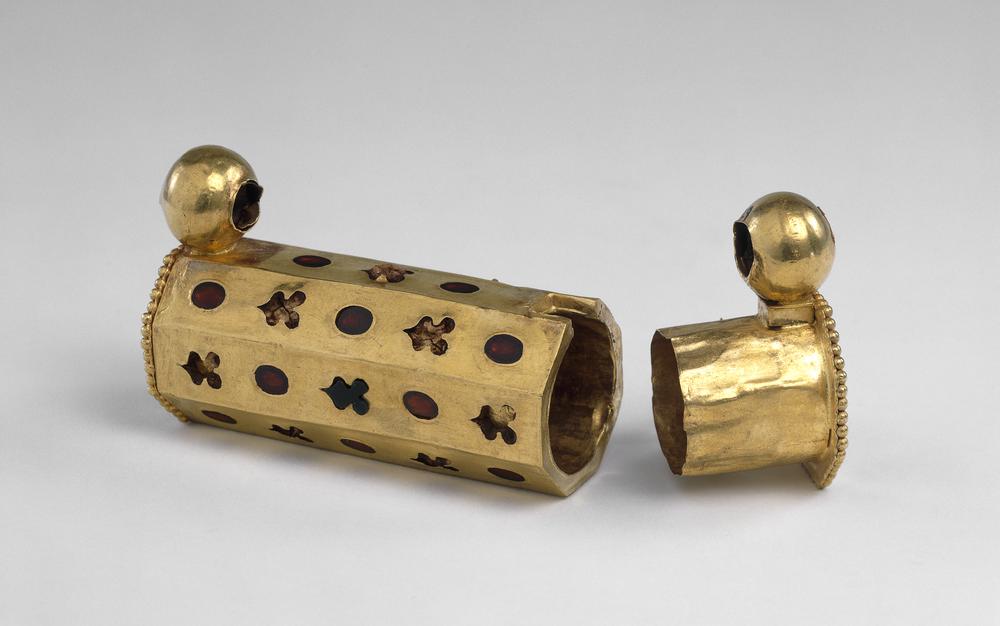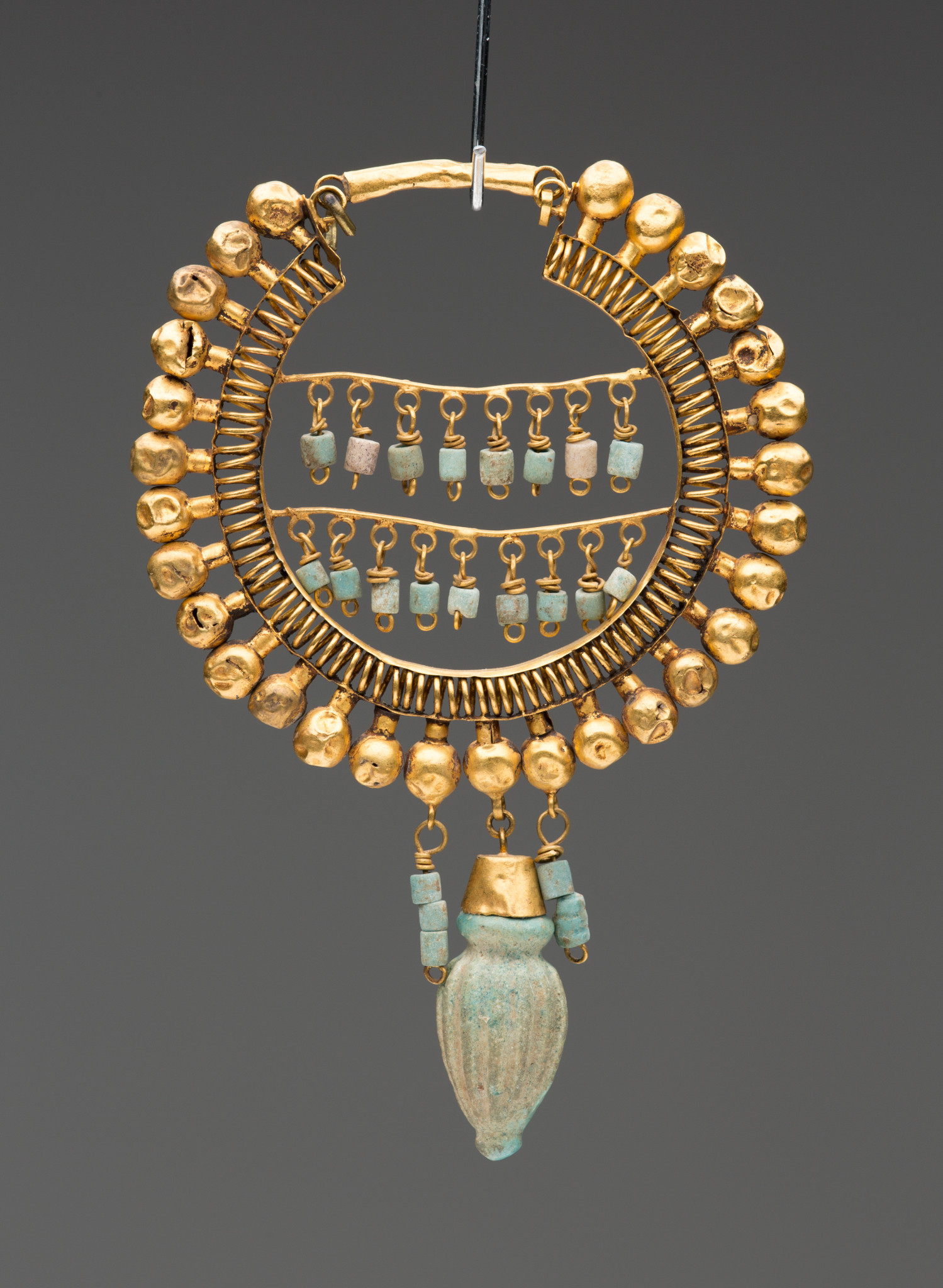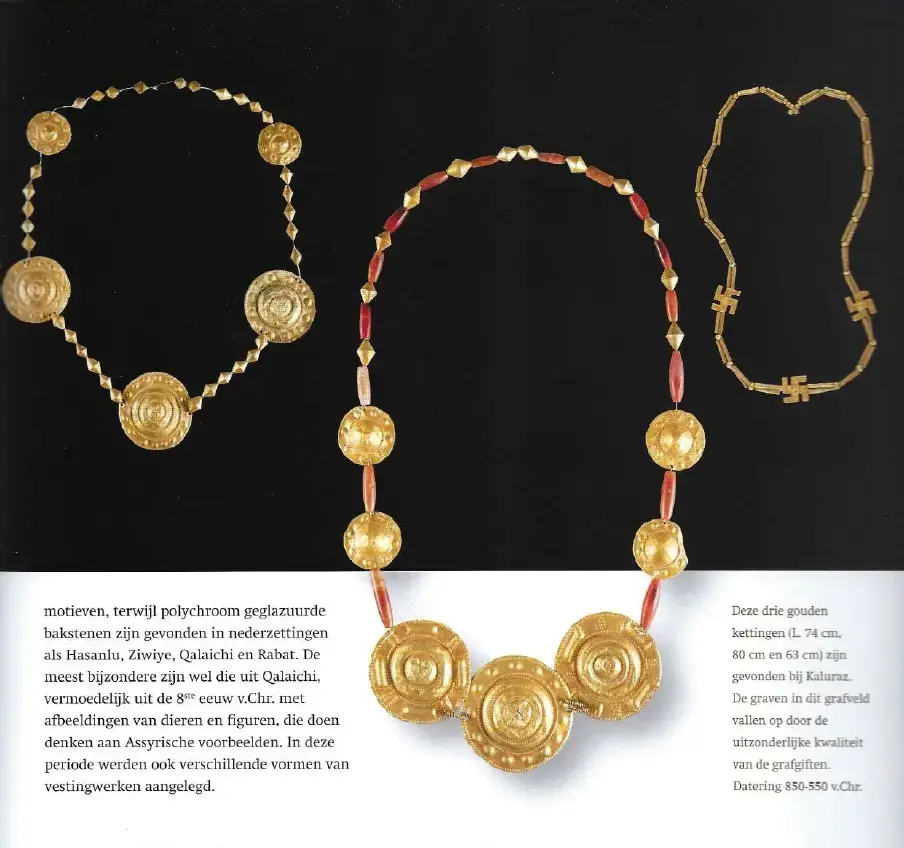

Bracelet, 1st Century BCE, from Taxila
W: 6.2 cm, Diam: 5.2 cm
“The gold bracelet with a decoration depicting rows of flat ‘S’ shaped pieces cut out from thick sheet gold within a plaited-chain border.”
According to the museum description – Indian artist, Harappan style.
More >> Private: Syria – Taxila – Kerch, bracelets http://colorsandstones.eu
Gold bangle; 1st cent. BCE
Dimensions 5 X 4.2 cm
“The bracelet with double ‘S’ repeat design cut from thick sheet gold with a beaded border on either side. The square hinged clasp with a circular hollow in the middle that must have held a gem, now missing and surrounded with leaf.”


Bracelet, 1st Century BCE, From Taxila
W: 6.5 Dia: 5.4 cm
“The gold bracelet with a square clasp, the broad sheet gold with a pattern of leaves and granules enclosed within a plaited chain border. The clasp decorated with hollow circular forms some set with crescent and round motifs in the four corners. The hinge and clasp formed of beaded tubing.”

https://twitter.com/IndiaHistorypic


National Museum, New Delhi Acc. no. 49.262/7

A necklace of gold, strung with pendants of alternating design. It is inlaid with crystal quartz, agate and shell. This necklace was found in an earthen pot.
“The gold necklace of eleven pendants with ten spacer beads and one terminal. The design of one pendant consists of an oval cabochon crystal set within a beaded surround enclosed by two repoussé worked dolphins face-to-face from the tails of which hang three plaited chains ending in flat gold disks. At the top is attached a spherical bead the surface fully decorated with micro-granules. The other pendant is of quatrefoil design with seven cloisonné inlaid with white orthoclase feldspar and three chains with flat gold disks hanging below; the bead on top of this pendant is plain. The spacer beads between each pendant are of openwork design of circles inlaid with white orthoclase feldspar and studded with granules. The terminal is in the form of an animal face inlaid with orthoclase feldspar and black agate outlined with granulated beading. While the necklace was strung through the beads, there is also a series of gold tubes at the back for another cord to pass through.” NMND


Acc. no. 49.262/6
Necklace from the 1st century Taxila, Sirkap
Gold, turquoise, garnet
13.5 X 3.2 cm
“A necklace of gold strung with pendants of alternating design and an end piece. One pendant centering on a flat disc set with a garnet in the center surrounded with a beaded rim surmounted with a bead covered with micro granules and an attachment below decorated with triple cluster of granules in the middle.”

Alamkara, the beauty of ornament / text & research, Dr. Usha R. Balakrishnan, 2015
https://www.exoticindiaart.com

Necklace from the 1st century Taxila, Sirkap
Gold, turquoise, garnet
National Museum, New Delhi
Acc. no. 49.262/6

A Jewelled Splendour: The Tradition of Indian Jewellery, Asharani Mathur
https://books.google.pl


“The necklace or amulet with a center piece in the form of a hollow gold bead surmounted with a palmette worked in repousse”
Taxila, 100 CE
Dimensions 10.7 cm

Bhir Mound, Taxila, 300 BCE

National Museum, New Delhi 49.262/14
“The pieces might have been part of a waist girdle comprising three horizontal rows of four fishes made of thin sheet gold stamped with a design of fish scales. Holes are pierced in their mouth and tails for the cords to pass through.”


49.262/38
1st cent. CE, Sirkap, Taxila
Dimensions Dia: 14 cm
“The hollow gold torque of beaten sheet gold over a lac core with trumpet-shaped ends in front. Formed of two semi circles increasing in diameter towards the end is united at the narrow ends by tenon-and-socket hinge and a (push) fastener at the trumpet-shaped ends.”

c. 300 BCE, Bhir Mound, Taxila
Dimensions Dia: 14 cm
“The tubular gold armlet or bangle terminating in lion’ s heads is made of thin sheet gold filled with lac. The lions heads are made separately with fine details in repousse”

National Museum, New Delhi
https://museumsofindia.gov.in/repository/record/nat_del-49-262-37-10493


http://jameelcentre.ashmolean.org/object/EA1996.103
Ring with bust figure holding a wine cup, gold, inset with a semi-precious stone. Bezel 2.9 x 2.5 cm
Gandhara, 1st century

Hinged Armlet, 1st century

Pair of Ear Plugs with Hamsas (Wild Geese), 1st century
diam. 2.7 cm


Gold hairpin, 1st cent. BCE
Dimensions L 11.1 cm x Dia 1.7 cm
“The hair pin of gold with flat wheel head decorated on both sides with a five-petalled flower inlaid and encircled by two rows of gold beading.”

Gold, 1st-2nd century, Taxila. Possibly a part of a hairpin.
“The figure stands on a lotus pedestal, holding the mirror in her left hand. A small figure of a woman swathed in a sari which clings closely at her breasts.”




http://jameelcentre.ashmolean.org
Gandhara 2nd century; 4.2 x 1.8 x 1.3 cm max
[Parthian type]


http://jameelcentre.ashmolean.org
2nd – 1st century BCE, Gandhara / Bactria
Gold, lapis lazuli, ivory and quartz; length 4.1 and 4.5 cm.
[Greek / Hellenistic. The earrings look like to be composed of several items, such as earrings and a necklace.]


Dimensions (a): 7.4 X 4.1 cm (b): 7 X 4.1 cm
From Sirkap, Taxila, National Museum, New Delhi
Accession Number: 49.262/12 (a-b)
second photo
“The ‘leech-and-pendant’ type earrings combines sheet gold and granulation.
Of crescent or ‘leech’ form the term derived from the insect of similar shape – the piece is hollow, with an inverted bud-shaped pendant suspended from it attached to a moveable ring embossed with gold granules. The clasp in the form of a double-leech pattern ornamented with decorative details. The pendent drops are covered with fine granulation with clusters of gold granules at the end. The hollow crescent forms are filled with a solid lac or pitch.”
“The earrings combines sheet gold and granulation of crescent form; the piece is hollow, with an inverted bud-shaped pendant suspended from it. This is attached to a moveable ring embossed with gold granules. The clasp in the form of a double- crescent pattern ornamented with decorative details. The pendent drops are covered with fine granulation with clusters of gold granules at the end. The hollow crescent forms are filled with a solid lac or pitch.”

Gold earrings, Sirkap, Taxila, 1st century
(a): 2.1 X 2.4 cm (b): 2.1 X 2.4 cm
“The earrings of heart-shape fashioned from hollow sheet gold with a pivot hinge on top of one and cluster of granules at the base.”
To compare




Parthian style gold ear-pendant, from Sirkap, Taxila, 1st Century BCE [Marshal excavation]

Gandhara, 1st century [Buddhist Jewels]


Gandhara, 1st-2nd century [Buddhist Jewels]

Pakistan, Taxila region (?), 1st-2nd century
Los Angeles County Museum of Art [record]

A gold pendant, 4×3.5 cm, the lunula inlaid with carnelian, the repousse bust is thought to be an image of Demeter.
It is said to be from Sardhderai, District Charsadda, Pakistan. Modern town of Charsadda was the capital of ancient Gandhara.
[A Note on Some Cultural Objects from District Charsadda]


Find Place Bhir Mound, Taxila
Period / Year of Work C. 300 BCE
Dimensions Dia: 3.7 cm
“Flat gold disc of crescent shape pierced on the upper two ends, the surface along the outline with two rows of gold dots worked in repousse”

Find Place Sirkap, Taxila
Period / Year of Work c.1st cent. BCE
Dimensions L 5.9 X Diam: 3 cm
“The gold disc-and-pendant ear jewel is in the form of a flat disc adorned in the center with a flower in full bloom. The inner row of petals is plain while the outer petals of triangular form are decorated with embossed granules. Between these petals are globules of gold. Around the flower are concentric bands of wire enclosing a row of ‘S’ shaped wires, two rows of plaited wire and a rim of twisted wire. From the bottom are suspended plaited chains and at the top is a flat loop behind”

[After Yan Liu, Jianjun Yu, Junchang Yang, Wenying Li]

“Greek Hellenistic Gold Filigree Earrings. 2nd century BC-1st century AD. A matched pair of gold earrings, each a hoop attached to a rosette with granule detailing, pendant amphora with dolphin handles, granule cluster and four dangles with pearl bed finials. 7.99 grams total, 34mm (1 1/4″). Property of a Mayfair gentleman; collected from 1966-2017.”

(b) Earring with beech-nut pendants, Sirkap, 1st century CE. After Krishnan & Kumar 2001:68, Fig.79;
(c) Earring from the Troy Treasure, Mesopotamia. 2200 BCE. After Schadt 1997:14, fig.13;
(d) Gold earrings from northeast Aegean, 2400 BCE. After Quick 2004:132, fig.120
[After Yan Liu, Jianjun Yu, Junchang Yang, Wenying Li]
Ear pendant with riders. Sirkap, Taxila, Khyber Pakhtunkhwa province 1st century CE. Gold and turquoise. H. 10.9 cm. National Museum of Pakistan, Karachi, 50.81

© The Fitzwilliam Museum, Cambridge
L: 4,25 cm


Сарматы в Северном Причерноморье.
// Сокровища сарматов. Каталог выставки. СПб; Азов: 2008. С. 4-11

“A GOLD HAIR ORNAMENT
Ancient Region of Gandhara, 1st century.
Rosette form with granulation on the pointed outer petals around natural rounded inner petals and an inset garnet, the whole supported by a twisted wire frame with beaded rosettes at the corners.
1.5 cm diameter
Provenance:
Private American Collection”

http://collections.vam.ac.uk/item/O17694/earring/earring-unknown/
http://collections.vam.ac.uk/item/O24944/jewellery-sculpture/
To compare:
Pendant and earrings from the Kushan Empire.


2nd–1st century CE, Cypriot
https://www.metmuseum.org
“Winged Aphrodite”
Gold ornament, 1st century, Taxila, Sirkap
National Museum of Pakistan, Karachi
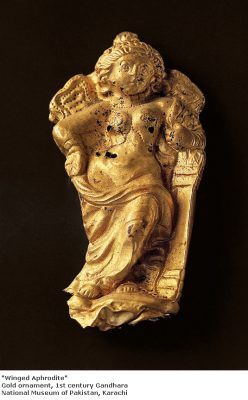
A gold ornament depicting a winged Aphrodite leaning against a column. She wears armlets, bracelets, and a crossed band across her chest. The thin gold sheets used to create the relief were probably made in stone or metal molds, and then the details were worked with a punch and hammer. There are three small rings for hanging on the back, two behind the wings and one behind the legs.
[source: The catalog of the exhibition “Gandhara Heritage along the Silk Road”, China, The Palace Museum 2023 https://gugongzhanlan.dpm.org.cn]
To compare:
1st century ornaments with Aphrodite from Tillya Tepe, Afganistan >>
http://colorsandstones.eu/2022/04/25/gandhara-tillya-tepe/
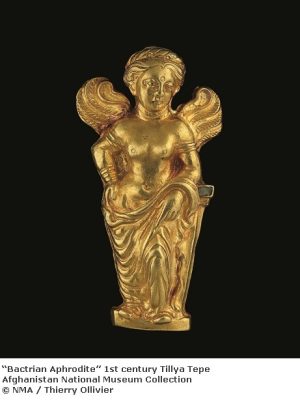


Gold ornament with an image of Eros and Psyche. H: 4.5 cm
Pakistan, Taxila; Sirkap, block D’, level III
Karachi, National Museum of Pakistan. In. no. SK/29-1241/1
A gold ornament, an embossed relief of Cupid and Psyche. There are three small rings on the back of the ornament for easy hanging, two in the middle and one behind the foot. There are two small holes at the bottom, through which lac or frankincense can be stuffed in. From the style, it seems to come from the West at first glance, but the heavy feeling shows that it should come from the East. This work shows how classical Greek art gradually adapted to Indian style. [source: The catalog of the exhibition “Gandhara Heritage along the Silk Road”, China, The Palace Museum 2023 https://gugongzhanlan.dpm.org.cn]
Hellenistic gold ornaments excavated by J. Marshall from Charsadda [the capital of ancient Gandhara, Pakistan]

Shaikhan Dheri, 1st century BCE
During the heavy rains of 2012 some Indo-Scythian burial sites in the ancient site of Shaikhan Dheri were destroyed. As a result a gilded silver bowl containing coins and jewelry was found.

After O. Bopearachchi
Lit.: From Hindu Kush to Salt Range, Osmund Bopearachchi and Susmita Basu Majumdar https://www.academia.edu
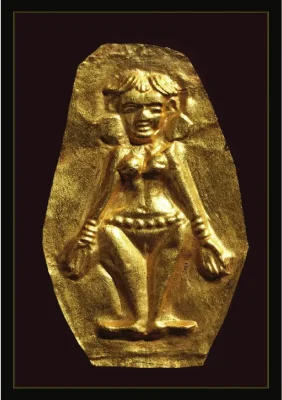
Ca. third to second century BCE. Gold; H. 3.26 cm, W. 2.08 cm. Indian Museum, Kolkata, Acc. No. A19746.
Source Naman P Ahuja

1st Century B.C. Gold
the National Museum, Delhi, Acc. No.: 49.262/9 & 49.262/10
[link]

“The swastika motif in these amulets are made in repoussé technique and surrounded by beaded borders. In the center, at the cross of arms, a diamond shaped depression is hollowed out, while the four ends of arms depict heart-shaped depressions. This was originally on a core of lac and has a provision of four copper ring-hooks at the back for convenient attachment.”
LITERATURE
- Buddhist Jewels in Mortuary Cult Magic Symbols, Arputharani Sengupta https://www.academia.edu/39589580/Buddhist_Jewels_in_Mortuary_Cult_Magic_Symbols
- A Note on Some Cultural Objects from District Charsadda, Khyber Pakhtunkhwa Mir Muhammad Khan and Asim Amin http://journals.uop.edu.pk
- Pakistan. Terre de rencontre Ier-VIe siècle. Les arts du Gandhara; Pierre Cambon
- The typology, production and adornment of Gandharan beads during the mid-3rd century BCE – 1st century CE: Preliminary results from Barikot, Swat, Pakistan; Mubariz Ahmed Rabban https://www.sciencedirect.com
- Yan Liu, Jianjun Yu, Junchang Yang, Wenying Li, LONG-DISTANCE RELATIONSHIP WITH THE MEDITERRANEAN WORLD? GOLD BEECH-NUT PENDANTS FOUND IN THE EARLY IRON AGE CHINA AND THE EURASIAN STEPPE http://maajournal.com
- A Buddhist Interpretation of Small Finds in the Early Historic Period; Naman P Ahuja
https://www.academia.edu - Francfort, H.-P., “Sur quelques vestiges et indices nouveaux de l’hellénisme dans les arts entre la Bactriane et le Gandhāra (130 av. J.-C.-100 apr. J.-C. environ)”, Journal des Savants, (janvier-juin), p. 3-114. https://www.academia.edu
- Артамонов М.И. Сокровища саков Artistic monuments of the Saks of Central Asia and Western Siberia














